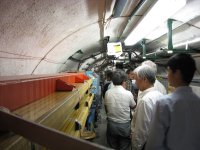 |
 |
|||||||||||||
|
|||||||||||||
|
|||||||||||||
|
There may not have been a ribbon-cutting ceremony or speeches by heads of state. But the official kick-off of Cornell University's CESR storage ring as ILC damping ring test facility pleased the nearly 40 participants at this week's "Joint CesrTA Kickoff Meeting and ILC Damping Rings R&D Workshop (ILCDR08)" enormously. “CesrTA will give us a detailed picture of the how electron cloud builds up under a range of conditions, of how an ultra-low emittance positron beam interacts with the electron cloud, and of how beam instabilities driven by the electron cloud develop,” says Andy Wolski, damping ring group leader based at the Cockcroft Institute in the UK. “In this respect CesrTA plays a critical role in validating the decision to reduce costs by eliminating the second positron damping ring.”
After a long, successful run with its CLEO detector, Cornell's Electron Storage Ring CESR shut down in spring this year as a high-energy physics machine. It continues its life as a synchrotron source, CHESS, and test accelerator for the ILC damping rings. Damping rings compact the electron and positron bunches to yield the high density needed to produce the targeted number of collisions inside the detectors. Some reconfigurations had to be made to make sure CESR-into-CesrTA meets the requirements and provides the damping ring experts with the data they need. One of the effects that they try to get rid of from the very beginning is the feared electron cloud. CesrTA is a great study object because of its many wigglers that will help them understand electron cloud build-up within the wigglers' strong magnetic field. It also shows them the effect an electron cloud has on a beam with very low emittance, i.e. a very small and homogenous beam. Some changes have to be made to the machine that runs underneath a playing field on the Cornell campus. A new lattice optics, for example, is being put in place for low horizontal emittance, a couple of wigglers have to be moved around the ring and the central part of the CLEO detector has to make way for more wigglers. On top of that, the team is installing additional instrumentation that lets them measure the electron cloud directly, check beam sizes extremely fast and with micron resolution, and control the beam. Along the ring, a new survey system is being installed to align all components to the accuracy needed for ultra-low vertical emittance. “Achieving all these changes on a limited timescale and with limited budget has been no mean feat,” says Wolski, also congratulating his Cornell colleagues on their idea to modify their machine “and for steering the proposal through a demanding approval process in a particularly difficult funding climate. They managed to adapt the programme to meet resource restrictions while retaining the essential value of the programme and build a strong international collaboration.” The collaboration also plans comprehensive tests of a range of techniques that they hope can stop the feared cloud from forming in the first place. They look at coatings with materials that have low secondary electron yield, meaning that any starting cloud would not be able to knock electrons out of the material so easily, and grooved chamber surfaces. This will help them find the best possible design of the vacuum system for the damping rings. The results will be collected in stages over the next two years. Project Manager Marc Ross appreciates the efficient interplay between scientific goals, the availability of the test facility and funds to support the GDE's plan of work there: “CesrTA fills a unique role as a dedicated test facility not only because it has positrons, but also because it has many superconducting wigglers, more than any other storage ring. The strong team and flexible well characterised infrastructure are also quite important,” he says. The meeting ends on Friday and you can follow the sessions by Webex. Click here for instructions. -- Barbara Warmbein This is part two of a series on how a storage ring at Cornell University morphs into a damping ring. |
|||||||||||||
| © International Linear Collider |
